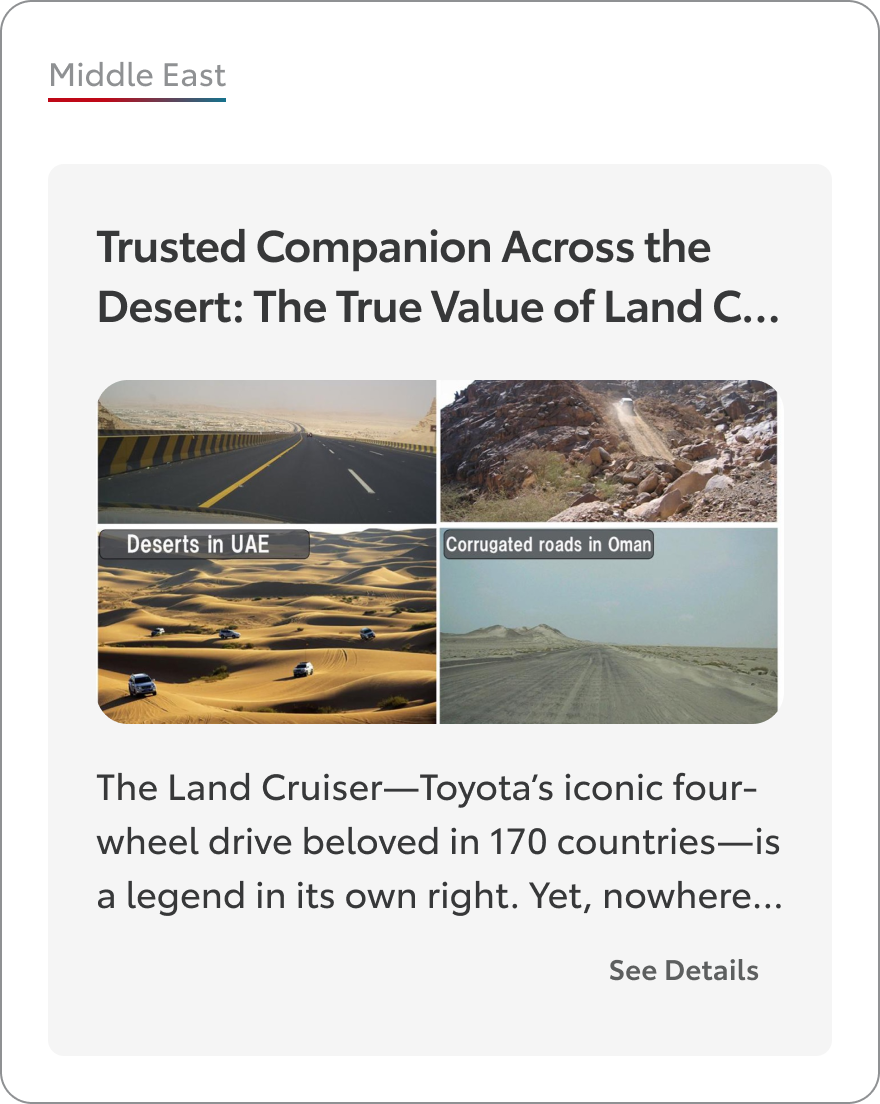Toyota Community
30 June 2025, 1:36 AM
The History and Heritage of the Land Cruiser
A One-of-a-Kind Vehicle That Can “Go Anywhere and Come Back Alive”

The first-generation BJ Series climbing from the fifth to the sixth station of Mt. Fuji.
There’s no other phrase that captures the essence of the Toyota Land Cruiser better than: “Go anywhere and come back alive.”
For over 70 years since its debut in 1951, the Land Cruiser has won the trust and affection of drivers in more than 170 countries, with cumulative production now surpassing 11.3 million units. But what isit that has elevated this vehicle to legendary status? By tracing its lineage, exploring the philosophy of its engineers, and delving into a trove of remarkable stories, we can get to the heart of what makes the Land Cruiser truly unique.
1. The Origins of the Land Cruiser
The Land Cruiser’s story begins in 1951, with the launch of the vehicle model Toyota BJ. At the time, prompted by requests from Japan’s National Police Reserve (the predecessor to the Self-Defense Forces) and the U.S. military, Toyota set out to develop a four-wheel-drive vehicle. Although the original BJ was not officially adopted by the U.S. military, its capabilities were proven by an extraordinary feat: driving under its own power to the sixth station of Mt. Fuji at an altitude of 2,700 meters. This pioneering spirit—and the conviction of chief developer Hanji Umehara tha “a vehicle without confidence inspires no trust”—became the bedrock of the Land Cruiser.
In 1954, the name “Land Cruiser”—meaning “cruiser of the land”—was bestowed upon the vehicle. It embodied a determination to “forge a path wherever one is needed.”
In 1954, the name “Land Cruiser”—meaning “cruiser of the land”—was bestowed upon the vehicle. It embodied a determination to “forge a path wherever one is needed.”

2. The Three Core Values the Land Cruiser Upholds
2-1. Reliability
At every stage of development, Land Cruiser engineers live by the principle of genchi genbutsu—“go to the source, see for yourself.” They travel to the world’s harshest environments, talk directly with local users, and experience firsthand how the vehicle is used. To ensure the promise of “go anywhere and come back alive,” the Land Cruiser is tested relentlessly to the point of failure, then improved again andagain.
2-2. Durability
Land Cruiser durability tests span as much as a million kilometers—the equivalent of circling the globe 25 times. Through a process known as “breakdown testing,” engineers push the vehicle to its limits, striving to create a vehicle that simply won’t break, no matter the environment. With every model change, there is an unyielding rule: the new model must match or exceed its predecessor in every respect. Anything less is unacceptable.
2-3. Off-Road Capability
The Land Cruiser’s mission is to conquer the world’s toughest terrains—deserts, snow and ice, mud, and rocky trails. To achieve this, Toyota has continually refined the ladder-frame chassis, four-wheel-drive systems, and electronic control features like Multi-Terrain Select, Crawl Control, and KDSS (Kinetic Dynamic Suspension System). The core development philosophy is clear: “The road builds the car. The car forges the road.”
3. The Evolving Land Cruiser Family Tree
Three Distinct Lineages
Over the decades, the Land Cruiser has diversified into three main lineages to meet evolving market demands:
-
Heavy Duty Series (e.g., 70 Series):
- Built with simplicity and ruggedness for demanding work and extreme environments. These models remain hugely popular worldwide.
-
Station Wagon Series (60, 80, 100, 200, 300 Series):
- The flagship models, combining comfort and advanced technology. They are in high demand in regions like the Middle East and Australia.
-
Light Duty Series (Prado, 250 Series):
- Versatile all-rounders suited for daily life and recreation. Recently, the “Prado” name has evolved into the “250 Series,” now positioned as a core Land Cruiser model.

Key Model Milestones
-
BJ Series (1951):
- The origin of the Land Cruiser, its prowess proven by climbing Mt. Fuji’s sixth station.
-
20 Series / 40 Series (from 1955):
- The Land Cruiser’s leap into global markets. The 40 Series was produced for 24 years and is still beloved worldwide.

The Land Cruiser 20 Series made its debut in 1955.

The Land Cruiser 40 Series launched in 1960.
-
55 Series / 60 Series (from 1967):
- The debut of the station wagon, catering to families and long-distance travel.

Derived from the 40 Series, the Land Cruiser 55 Series debuted in 1967 as the first-generation station wagon.

The second-generation station wagon the Land Cruiser 60 Series released in 1980.
-
70 Series (from 1984):
- The ultimate heavy-duty workhorse, customized for demanding jobs and harsh environments—still in production and constant evolution.

The 70 Series, the first generation of Heavy Duty models, debuted in 1984 as the successor to the 40 Series.

Returning to its roots, the 70 Series was revived in Japan in 2023.
-
80, 100, 200 Series (from 1989):
- The Land Cruiser’s transformation into a luxury SUV, offering both comfort and off-road capabilities.

Developed with a focus on providing comfort even under harsh conditions, the Land Cruiser 80 Series set a new benchmark.

The first-generation Prado launched as a light duty series to meet the extensive needs of the market.
-
300 Series (from 2021):
- The latest generation fuses cutting-edge technology with tradition, using the TNGA (Toyota New Global Architecture) platform for reduced weight, a lower center of gravity, and enhanced rigidity.


Following the 200 Series, the Land Cruiser 300 Series was released in 2021 as its successor.
-
250 Series (from 2024):
- The Prado’s successor and new core model, now available with a hybrid system to address environmental concerns.

4. Motorsports and the Pursuit of Ever-Better Cars
Forged by the Dakar Rally
Since the 1990s, the Land Cruiser has competed in the production car class of the Dakar Rally. The unwavering commitment: “Don’t aim for overall victory with a prototype; prove the car’s strength by conquering the world’s toughest roads in a production model.” The rally isn’t just a race—it’s a testbed where the same roads traversed by users worldwide are faced head on with the emphasis on speed, further honing the Land Cruiser’s durability and reliability.

Akira Miura won the T2 class for production cars at Dakar 2021, securing the eighth consecutive win for the Land Cruiser.
The Philosophy: “Roads Train People, People Build Cars”
At the core of Land Cruiser development is Toyota’s belief: “Roads train people, and people build cars.” Engineers and drivers forged in the field humbly listen to the voices of real users, and continuallyimprove the vehicle. “A car without confidence inspires no trust.” “Sweat for the customer.” These attitudes underpin the Land Cruiser legend.
5. Looking Ahead: A New Chapter for the Land Cruiser
“Back to the Origin” and New Challenges
In 2023, the Land Cruiser embraced a “back to basics” philosophy, unveiling the 250 Series to the world and reviving the 70 Series in Japan. The lineup continues to evolve, introducing hybrid systems and advanced safety technology to meet the needs of a changing era.

An Unchanging Mission
No matter how much technology advances, the Land Cruiser’s mission remains steadfast: “Go anywhere, and come back alive.” To keep this promise, the development team will keep listening to real-world feedback, pushing the car to its limits, and building a legacy of unmatched trust.
Conclusion
The Land Cruiser’s history is a story of relentless challenge, evolution, and the trust earned by protecting people’s lives and livelihoods. Having conquered the toughest roads on Earth, the Land Cruiser will undoubtedly continue to create new legends for generations to come. “There are places only a Land Cruiser can reach”—this enduring truth remains as relevant today as ever.
Related Episodes
Explore more stories from the Story of Land Cruiser channel

